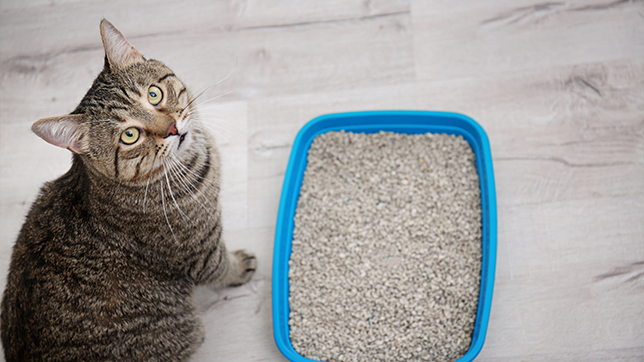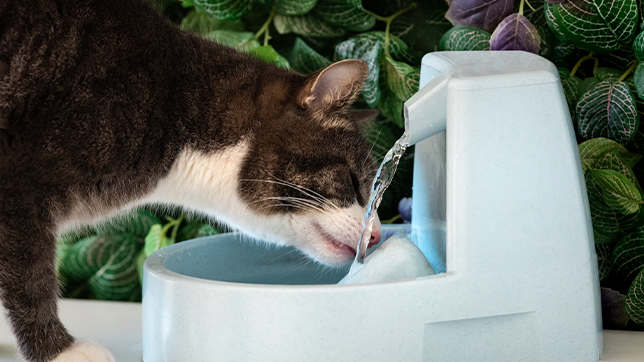29th May 2024
Feline lower urinary tract disease (FLUTD)
Since health disorders associated with FLUTD are common in domestic cats, it’s important to understand this collection of conditions – so you can keep your cat happy and healthy.
Let’s discover what feline lower urinary tract disease is, its potential causes, symptoms linked to FLUTD, how FLUTD is diagnosed, treatments, and ways you might prevent FLUTD…
What is feline lower urinary tract disease (FLUTD)?
Feline lower urinary tract disease describes a range of health conditions related to a cat’s bladder and/or urethra (a narrow tube that carries urine out of their bladder). Instances of FLUTD usually involve:
- Stale urine building up in the bladder, enabling bacteria and crystals to form.
- Formation of bladder stones.
- Inflammation of the bladder.
- Inflammation of the urethra.
- Partial or total obstruction (blockage) of the urethra.
There are some cats who are more likely to be at risk of FLUTD, including:
- Overweight cats.
- Neutered male cats.
- Middle-aged cats.
- Cats who have diabetes.
- Cats with pre-existing kidney disease.
- Cats who don’t have access to the outdoors.
- Cats who live in multi-cat households.
- Cats who only use indoor litter trays.
- Cats who are unlikely to exercise much.
- Cats who have a diet made up of only dry food.
What causes feline lower urinary tract disease (FLUTD)?
Although we now know the various mechanisms that create feline lower urinary tract disease, like inflammation of the bladder (see above!), it’s useful to understand its potential causes. So, here are some of the possible causes of FLUTD:
- Stress – experiences that cause stress (e.g. moving house) can have a negative impact on a cat’s willingness and/or ability to pee.
- Diet – dry food diets often reduce a cat’s water intake; though if a cat isn’t getting the right balance of minerals, their urine pH could be affected, too.
- Inactivity – cats who are overweight, dislike exercising, or live exclusively indoors may become too lazy to pee often enough; or accustomed to peeing less frequently, allowing crystals to form in the bladder.
- Infections – that are viral or bacterial, e.g. a bacterial infection of the bladder (‘bacterial cystitis’), which tends to be more common in older cats.
- Bladder stones – also known as ‘urolithiasis’, bladder or urinary stones prevent cats from peeing.
- Urethral plugs – obstructions created by an accumulation of debris (e.g. proteins, crystals, and small bladder stones) in the urine that can’t be passed.
- Muscle spasms of the urethra – can create severe inflammation.
- Abnormal structure of the lower urinary tract – defects in the structure of their urethra, for example, could mean that any damage results in healed tissue restricting the size of the urethra.
- Cancer – tumours in the urethra or bladder, e.g. ‘transitional cell carcinoma’, make it difficult for cats to pass urine.
- Disease or trauma to the pelvis or back end – affecting the nerves that control a cat’s bladder.
Important: When cats develop FLUTD without a clear underlying cause, a vet may describe the condition as ‘idiopathic FLUTD’ or ‘feline idiopathic cystitis (FIC)’ – which is similar to cystitis in humans.

What are the symptoms of feline lower urinary tract disease (FLUTD)?
Noticing the symptoms of feline lower urinary tract disease is a vital first step towards helping your cat feel better. Here are several FLUTD symptoms to look out for in your cat:
- Straining to pee.
- Pain while peeing, e.g. crying out.
- Peeing more often than usual.
- Urgently needing to pee.
- Toileting in inappropriate or unusual places.
- Only producing small amounts of urine.
- Blood in their urine.
- Overgrooming of their backend.
- Behavioural changes, e.g. aggression.
- Hiding away.
- Refusing to drink.
- Refusing to eat.
- Lethargy.
- Vomiting.
- Inability to pee.
If your cat is unable to pee, this is an emergency, and you’ll need to rush them to a vet straight away.
How is feline lower urinary tract disease (FLUTD) diagnosed?
Given that FLUTD describes a group of health conditions, it can be challenging for vets to provide an accurate diagnosis as to the exact cause of your cat’s symptoms. However, your vet is likely to carry out the following tests before diagnosing your cat with feline lower urinary tract disease:
- They’ll ask for your cat’s full history, including information about their diet, behaviour, and symptoms you’ve noticed.
- A full physical examination will be carried out, which enables your vet to check the state of your cat’s bladder and other organs.
- Urine samples are needed, so they can be tested for acidity, crystals, protein, blood cells, and bacteria that might be present.
- Based on the results of your cat’s urine test, your vet might perform a blood test to confirm a condition like diabetes or kidney disease.
- Your vet may perform x-rays or ultrasound scans (with your cat under anaesthetic) to identify abnormalities in the bladder and/or urethra.
- Should all the above steps remain inconclusive, your vet might need to perform a biopsy (take tissue samples while your cat is under anaesthetic) in hope of finding answers.
How is feline lower urinary tract disease (FLUTD) treated?
Once feline lower urinary tract disease is diagnosed, the course of treatment your vet prescribes will depend on the underlying cause of your cat’s symptoms.
Following are examples of the potential treatments a vet might prescribe, based on the underlying cause of your cat's FLUTD:
Treatments for stress – find the cause, e.g. being bullied by another cat, and work with your vet to relieve your cat’s stress; which could involve a vet-approved pheromone diffuser.
Treatments for diet – you may be advised to switch your cat’s diet to a specific type of food designed to improve the health of their urinary tract.
Treatments for inactivity – supporting your cat to move more, by increasing playtime, taking them for walks, or building an outdoor ‘catio’ with a network of climbing apparatus.
Treatments for infections – antibiotics could be prescribed by the vet if your cat has a bacterial infection. As true urine infections in cats remain infrequent, it is important to confirm that a bacterial infection is present before your vet gives your cat antibiotics.
Treatments for bladder stones – depending on the type of bladder stones your cat has, it might be possible to dissolve them through a change in diet; other types of bladder stones require surgery to remove.
Treatments for urethral plugs – urethral plugs are composed of minerals and organic matrix (dead cells from the bladder, inflammatory cells, etc), so treatments will differ depending on their structure. To find out more, read this article by the College of Veterinary Medicine and visit this great resource by International Cat Care.
Treatments for muscle spasms of the urethra – a vet could give medication to relax your cat’s bladder muscles.
Treatments for cancer – alongside chemotherapy, your vet is likely to prescribe anti-inflammatory medication if tumours are the cause of your cat’s FLUTD.
Other treatments your vet may prescribe for feline lower urinary tract disease include:
- Supplements to repair the inner lining of their bladder.
- Painkillers and anti-inflammatory medication to ease discomfort.
- Increasing your cat’s exercise and managing their diet to support weight loss and to prevent further crystals forming (crystal dissolution diets etc).
- Anti-depressant medication might be recommended in severe cases.
How to prevent feline lower urinary tract disease (FLUTD)
A significant step towards preventing feline lower urinary tract disease is ensuring your cat drinks enough water. The more your cat drinks, there’s greater chance they’ll urinate frequently and less opportunity for urine to stay in their bladder long enough to cause problems.
Encouraging your cat to drink can take some trial and error, as you work towards discovering their preferences. To help you, check out our top tips for inspiring your cat to drink more water:
- Put a water dish in every room (though not near their litter trays!), and make sure they’re always topped-up with fresh drinking water.
- If your cat likes to drink running water, you could get a drinking fountain made specifically for cats. This will save water over letting a tap drip in the house all day!
- Add water to your cat’s dry food or start introducing tinned food to your feline friend’s diet.

For further advice about making sure your cat is drinking enough, chat to the vet experts over at Joii Pet Care, at any time, day or night, via their app!
Free vet video calls for your cat
24/7/365 with the Joii app.
Our partnership with Joii Pet Care gives Animal Friends policyholders free online veterinary help, whenever and wherever they need it. Download the Joii app today.
The vets and nurses at Joii can provide you with veterinary advice, preventative care and diet plans. Free and exclusive to Animal Friends customers. T&C's apply
Looking for more cat advice?
We’ve written some handy cat advice guides, to help you unlock the secrets of your mysterious moggy.
Save animals with us
Protecting your pet is our purpose, animal welfare is our passion.
